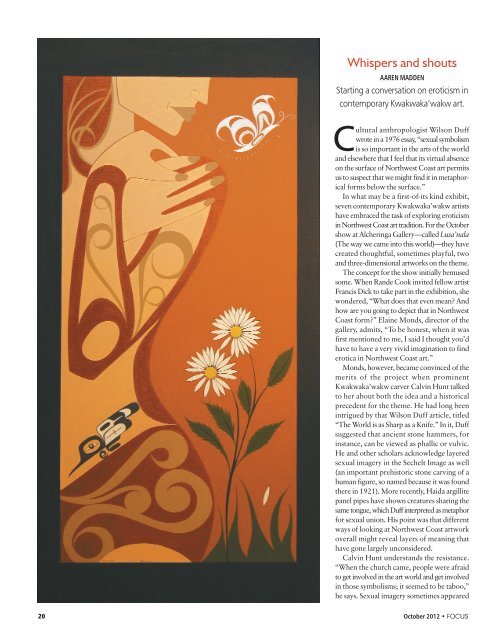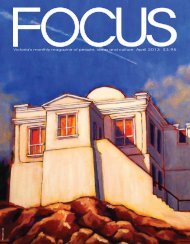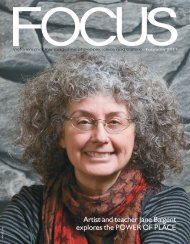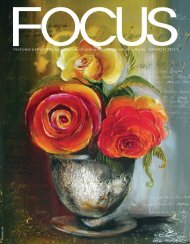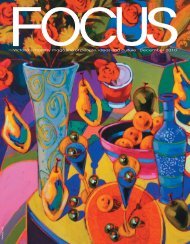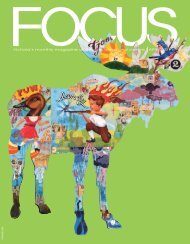**October 2012 Focus - Focus Magazine
**October 2012 Focus - Focus Magazine
**October 2012 Focus - Focus Magazine
Create successful ePaper yourself
Turn your PDF publications into a flip-book with our unique Google optimized e-Paper software.
Whispers and shouts<br />
AAREN MADDEN<br />
Starting a conversation on eroticism in<br />
contemporary Kwakwaka’wakw art.<br />
Cultural anthropologist Wilson Duff<br />
wrote in a 1976 essay, “sexual symbolism<br />
is so important in the arts of the world<br />
and elsewhere that I feel that its virtual absence<br />
on the surface of Northwest Coast art permits<br />
us to suspect that we might find it in metaphorical<br />
forms below the surface.”<br />
In what may be a first-of-its kind exhibit,<br />
seven contemporary Kwakwaka’wakw artists<br />
have embraced the task of exploring eroticism<br />
in Northwest Coast art tradition. For the October<br />
show at Alcheringa Gallery—called Lusa’nala<br />
(The way we came into this world)—they have<br />
created thoughtful, sometimes playful, two<br />
and three-dimensional artworks on the theme.<br />
The concept for the show initially bemused<br />
some. When Rande Cook invited fellow artist<br />
Francis Dick to take part in the exhibition, she<br />
wondered, “What does that even mean? And<br />
how are you going to depict that in Northwest<br />
Coast form?” Elaine Monds, director of the<br />
gallery, admits, “To be honest, when it was<br />
first mentioned to me, I said I thought you’d<br />
have to have a very vivid imagination to find<br />
erotica in Northwest Coast art.”<br />
Monds, however, became convinced of the<br />
merits of the project when prominent<br />
Kwakwaka’wakw carver Calvin Hunt talked<br />
to her about both the idea and a historical<br />
precedent for the theme. He had long been<br />
intrigued by that Wilson Duff article, titled<br />
“The World is as Sharp as a Knife.” In it, Duff<br />
suggested that ancient stone hammers, for<br />
instance, can be viewed as phallic or vulvic.<br />
He and other scholars acknowledge layered<br />
sexual imagery in the Sechelt Image as well<br />
(an important prehistoric stone carving of a<br />
human figure, so named because it was found<br />
there in 1921). More recently, Haida argillite<br />
panel pipes have shown creatures sharing the<br />
same tongue, which Duff interpreted as metaphor<br />
for sexual union. His point was that different<br />
ways of looking at Northwest Coast artwork<br />
overall might reveal layers of meaning that<br />
have gone largely unconsidered.<br />
Calvin Hunt understands the resistance.<br />
“When the church came, people were afraid<br />
to get involved in the art world and get involved<br />
in those symbolisms; it seemed to be taboo,”<br />
he says. Sexual imagery sometimes appeared<br />
20 October <strong>2012</strong> • FOCUS


